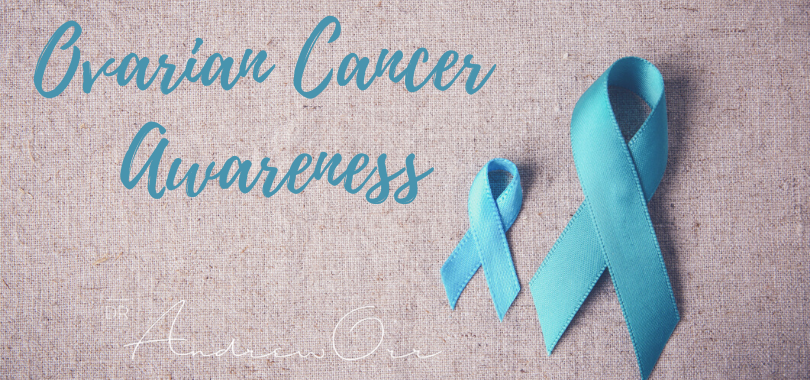Ovarian cancer often has no symptoms in the early stages. Later stages are associated with symptoms, but they can be non-specific, such as loss of appetite and weight loss.
Ovarian cancer often goes undetected until it has spread within the pelvis and stomach. At this late stage, ovarian cancer is more difficult to treat and can be fatal. This is why early intervention is something I am very big on and why we all need to not put things off when they present themselves.
Ovarian cancer is the 9th most common cancer diagnosed in Australian women.
Ovarian cancer is the 6th most common cause of cancer death in Australian women.
The present life expectancy of Australian women is 84 years. One in 77 women will be diagnosed with ovarian cancer before the age of 85.The risk of ovarian cancer increases with age. About 83% of all new cases of ovarian cancer diagnosed in 2005 were in women 50 years or older. The median age of first diagnosis is 64 years.
The five year survival rate for ovarian cancer is 45%.
Symptoms
Most women with ovarian cancer experience at least one symptom of the disease in the year prior to their diagnosis. The following can all be signs of ovarian cancer:
- Abdominal bloating
- Abdominal or back pain
- Appetite loss or feeling full quickly
- Changes in bowel habit
- Urinary frequency or incontinence
- Pain during intercourse
- Menstrual irregularities
- Unexplained weight loss or gain
- Indigestion or heartburn
Why is bloating a sign of ovarian cancer?
Ascites (a build-up of fluid in the abdomen and a sign of advanced ovarian cancer) is probably the major cause of bloating in women with ovarian cancer. Therefore, waiting for bloating as a key ‘sign’ is too late and we want to encourage all women to ‘know your normal’ and if this changes, to seek medical help. This is why any changes in the body need to be looked into. Many may think that they are reacting to foods, or they have a gut issue etc, but it may actually be the signs of ovarian cancer. This is why proper investigations and proper differential diagnosis by a trained professional is so important.
Family history
While having a family history of ovarian cancer increases a woman’s risk of developing ovarian cancer, 90-95 per cent of all ovarian cancers occur in women who do not have a family history.
Key factors associated with increased risk include:
- Multiple relatives on the same side of the family affected by breast cancer (male or female) or ovarian cancer
- Younger age at cancer diagnosis in relatives
- Relatives affected by both breast and ovarian cancer
- Relatives affected with bilateral breast cancer
- An increase in age
- Inheriting a faulty gene (called a gene mutation) that increases the risk of ovarian cancer
- Being Caucasian (white) and living in a Western country with a high standard of living having few or no full-term pregnancies
- Starting your menstrual cycle early (before the age of 12) and beginning menopause after the age of 50
- Taking hormone therapy (HT) after menopause. Some studies suggest this may increase your risk of developing ovarian cancer, but others don’t make this connection
- Never having taken the contraceptive pill – the pill has been found to reduce the risk of cancer of the ovaries and uterus
- Only five to 10 per cent of all ovarian cancers are associated with a family history. The risk of developing ovarian cancer increases with the number of affected first degree relatives (parents, siblings, children)
- Ashkenazi Jewish ancestry.
Diagnosis for Ovarian Cancer
There is currently no evidence to support the use of any test, including pelvic examination, CA125 or other biomarkers, ultrasound (including transvaginal ultrasound), or a combination of tests, to screen for ovarian cancer. The only way to properly screen for it is through histology done at the time of laparoscopy.
While CA126 can be a diagnostic, it really has limited value and I have to let people know that it isn’t the best diagnostic at all. 50% of ovarian cancers will actually have a normal CA125 reading.
The cancer council’s guidelines are quite clear about this after numerous research studies show that CA125 has limited diagnostic value for Ovarian cancer. If markers and symptoms are suggestive of Ovarian Cancer, the only true diagnostic is Laparoscopy with histology to really get an accurate diagnosis.
Treatment for Ovarian Cancer
At such an advanced stage, the cancer is more difficult to cure. As ovarian cancer advances, cells from the original tumor can spread (metastasize) throughout the pelvic and abdominal regions and travel to other parts of the body. Cancer cells are carried through the body through lymph vessels and the bloodstream.
If a woman is suspected of having ovarian cancer, she should be referred to a gynaecological oncologist. Research shows survival for women with ovarian cancer is improved when their surgical care is directed by a gynaecological oncologist.
Treatment for ovarian cancer usually involves surgery and chemotherapy. It may also include radiotherapy.
Usually your healthcare practitioner, or GP, will generally arrange for initial tests and looks after your general health as well as coordinating with your specialists. Depending on your treatment you will be seen by several specialists, such as: medical oncologist, radiation oncologist, radiologist, gynaecological pathologist, cancer nurses and other health professionals such as a dietitian, physiotherapist, social worker and a counsellor.
With any condition that affects the body, we often get early warning signs and this is why early intervention and making sure you are investigated and management properly is so important.
Regards
Andrew Orr
-Women’s and Men’s Health crusader
-No Stone Left Unturned
-The Women’s Health Experts


